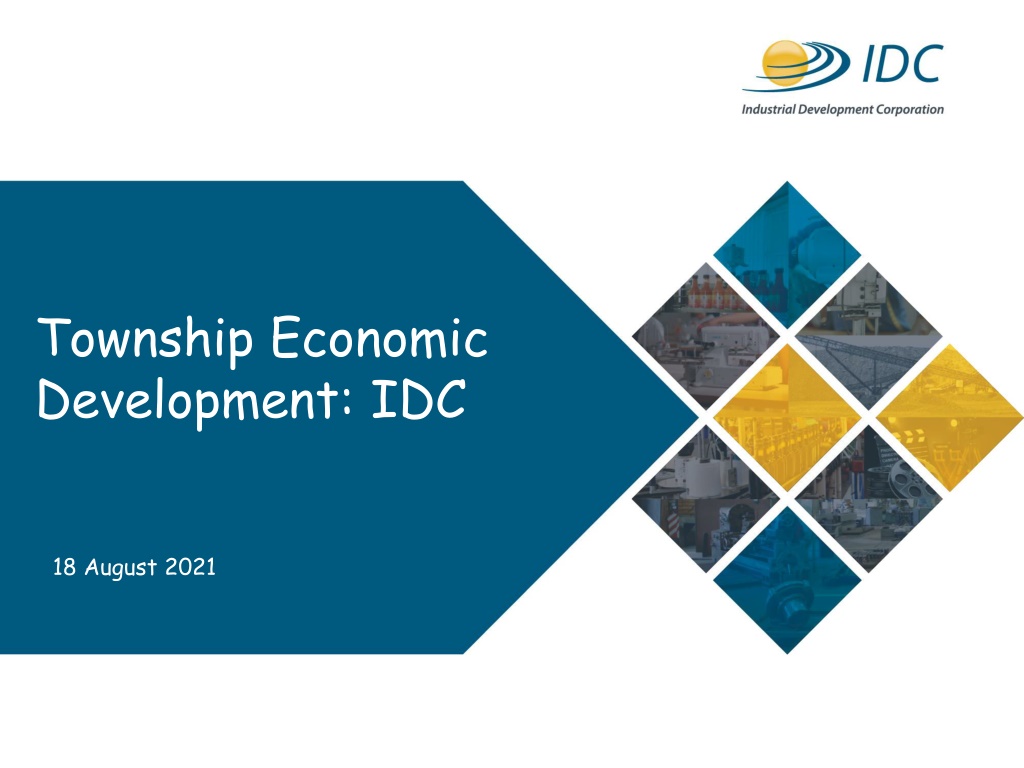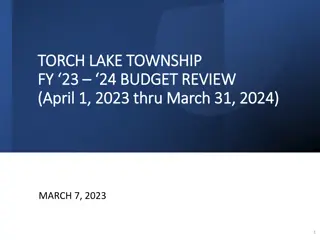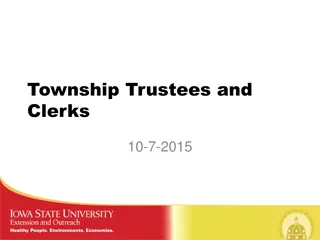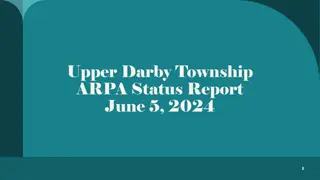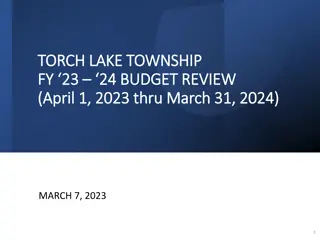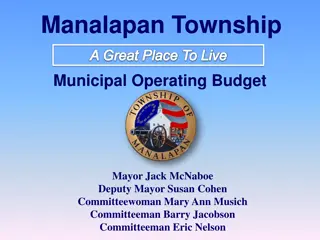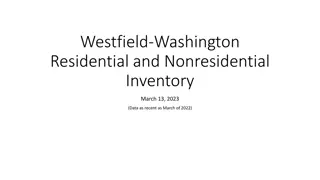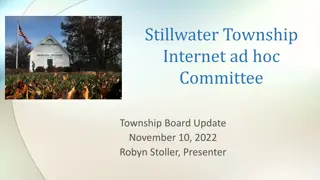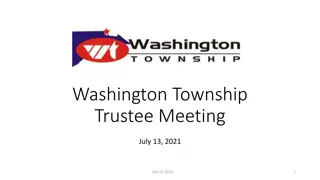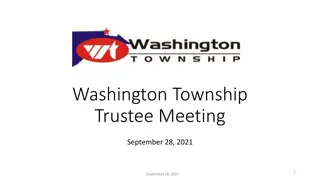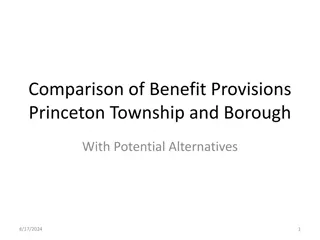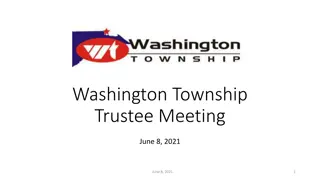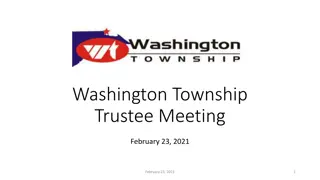Challenges and Opportunities in Township Economic Development
South African townships face significant challenges such as low investment, high levels of financial leakage, limited infrastructure, and high unemployment rates. Despite these obstacles, townships also serve as vibrant hubs of entrepreneurship with a variety of thriving activities. However, there is a lack of focus on investing in townships and leveraging their potential for fast growth. The current investment patterns often neglect townships, perpetuating the transfer of wealth to other areas. This highlights the need for strategic action plans and a shift in mindset to unlock the economic potential of townships.
Download Presentation

Please find below an Image/Link to download the presentation.
The content on the website is provided AS IS for your information and personal use only. It may not be sold, licensed, or shared on other websites without obtaining consent from the author. Download presentation by click this link. If you encounter any issues during the download, it is possible that the publisher has removed the file from their server.
E N D
Presentation Transcript
Township Economic Development: IDC 18 August 2021
SA townships are beset with wicked problems Low investment in people, places and productive activities High levels of financial leakage and poor resource retention Restricted linkages with formal value chains elsewhere Poor economic infrastructure banks, business services, logistics, serviced land, industrial areas, business parks, business incubators, etc. Low capacity networked infrastructure electricity, water, sanitation systems, etc. Limited entrepreneurial traditions, business capabilities and vocational skills High population densities with many low-income households possessing low purchasing power High levels of unemployment, poverty and social ills Inadequate public facilities and social amenities Unsupportive economic institutions and governance arrangements 2
Townships are also places of thriving activity Townships are vibrant hubs of entrepreneurship and survivalist enterprises. Yet, activities are not scaled enough to generate re-investment returns Personal & Social Services Hairdressing and beauty Barber shops Day care Funeral services Music & entertainment Construction & home improvement Car repairs & panel beating Alterations & tailoring Backyard rental Medical Money lending Recycling Small Scale Manufacturing Metal work Food processing Brickmaking Clothing Retail Transportation Agriculture Minibus taxi Bus services School transport Worker transport Funeral transport Shebeens Spaza shops Fast food & street food Street trading Catering Building materials Secondhand car sales Cellphone Butchers Backyard farming of livestock including chicken, cattle and goats Backyard vegetable growers Abattoirs Key Assumptions: Most business models structured towards survival with tight margins and very little pricing power (some exceptions likely) Very little savings left for re-investment Sub-optimal asset accumulation Growth driven largely by meagre internal resources Transactions largely cash-based Profits largely transferred to the core economy 3 Source: CITIES Network, 2018
Townships largely ignored for investment Dominant paradigm is to view townships as in need of CSI rather than potential nodes of fast growth Mindsets are not geared towards township investment Limited products to address market failures in townships Limited strategy, targets and action plans to invest in township economies Investment patterns indirectly perpetuate the transfer of wealth ie. Alex to Sandton Accept huge risks elsewhere, very little in townships! We are forced to ask ourselves the following questions: Of our current impairments, how many businesses are in the townships? Of our current business failures, how many businesses are in the townships? 4
Reframing the township economic development problem Our narrow framing of township economic development as upgrading or rejuvenation provides a limited perspective to what is possible. We need to think bigger Investment in Infrastructure People Enterprise Township economic development Our Future Cities 5
IDC and Township Development In recent time, IDC has placed a special focus on supporting and growing the Township Economy. This support has been directed primarily through three pathways, namely : Financing of projects and businesses located in townships through normal IDC business; Social Impact Funding mechanisms and initiatives; and Innovative solutions and strategies. Amongst the IDC s mandate performance areas related directly to the support of township economies, are to: Create inclusive employment opportunities; Support local economic development initiatives; Fostering entrepreneurship and supporting the SME sector (particularly youth, women, Black Industrialist, disabled); and, Being a catalyst for private and public sector investments. 6
Township Investments Last 15 years in excess of R10bn in over 300 transactions approved within townships (remember IDC excluded from retail, services and buy-outs). Best performing sectors include: o ICT (>60 transactions) o Metals, transport and machinery products (>40) o Chemical and allied industries (>40) o Agro-processing and agriculture (>20) o Also >50 social funding transactions 7
IDC and Township Development The general goals of IDC s Township Economy Investment Strategy link social improvement with economic progress and sustainable development practices; and, includes supporting initiatives that seek to: Stimulate economic activity, job creation, skills development and employment of local people; Facilitate viable and sustainable enterprise development; and, Improve the living environment through supporting the provision of social amenities, community services, safety and security; and, the like. The IDC s Township Economy Investment Strategy rests on three key pillars of intervention: To retain and expand existing township enterprises; To identify opportunities and markets for township enterprises; and, To create a more supportive environment for township enterprises to thrive (ie. Supporting enabling infrastructure and the ecosystem). 8
Some interventions/Actions Retention and Expansion o Funding, workspace, business support o Replications and scaling o Un- and Under-utilized assets (RRR) o Partnerships Opportunities and Markets o Industry development plans o SME-Connect o Inclusive business strategies o Statutory obligations o Partnerships o new opportunities Supportive and enabling environment o Access to appropriate financial support o More appropriate internal systems and processes to support township economy o Financial incentives and discounted pricing 9
IDC Township Strategy Broad IDC offering: Various tools and methodologies; Various financial instruments and support; Expertise and knowledge (especially industry sectors) Access to information, networks and linkages, research capabilities; and Business acumen and project management support. It snot a one way street, IDC realizes it too can also benefit: Proactive identification of new opportunities, upstream and downstream linkages to current investments; Meeting of development mandate, developmental outcomes and targets; and, Long-term sustainable economic development. 10
Gauteng and other Partnership examples Participation in Gauteng Province War Room Programme. Implementation of Township Economy Partnership Fund (TEPF) initiative (R250m) including : o Backyard real estate/ township high streets and township o Wholesale and retail development o Taxi economy o Ensure efficient and targeted distribution funding for: - Youth job creation - Enabling market access opportunities for township enterprises - Lowering barriers of entry - Leverage strategic partnerships and technical skills - Deployment of technology - Township broadband investment Smart township application in Vaal with partners (Gauteng, RRS, Siemanns etc. o Energy o Water o ICT o Transport and logistics Unrest response 11
